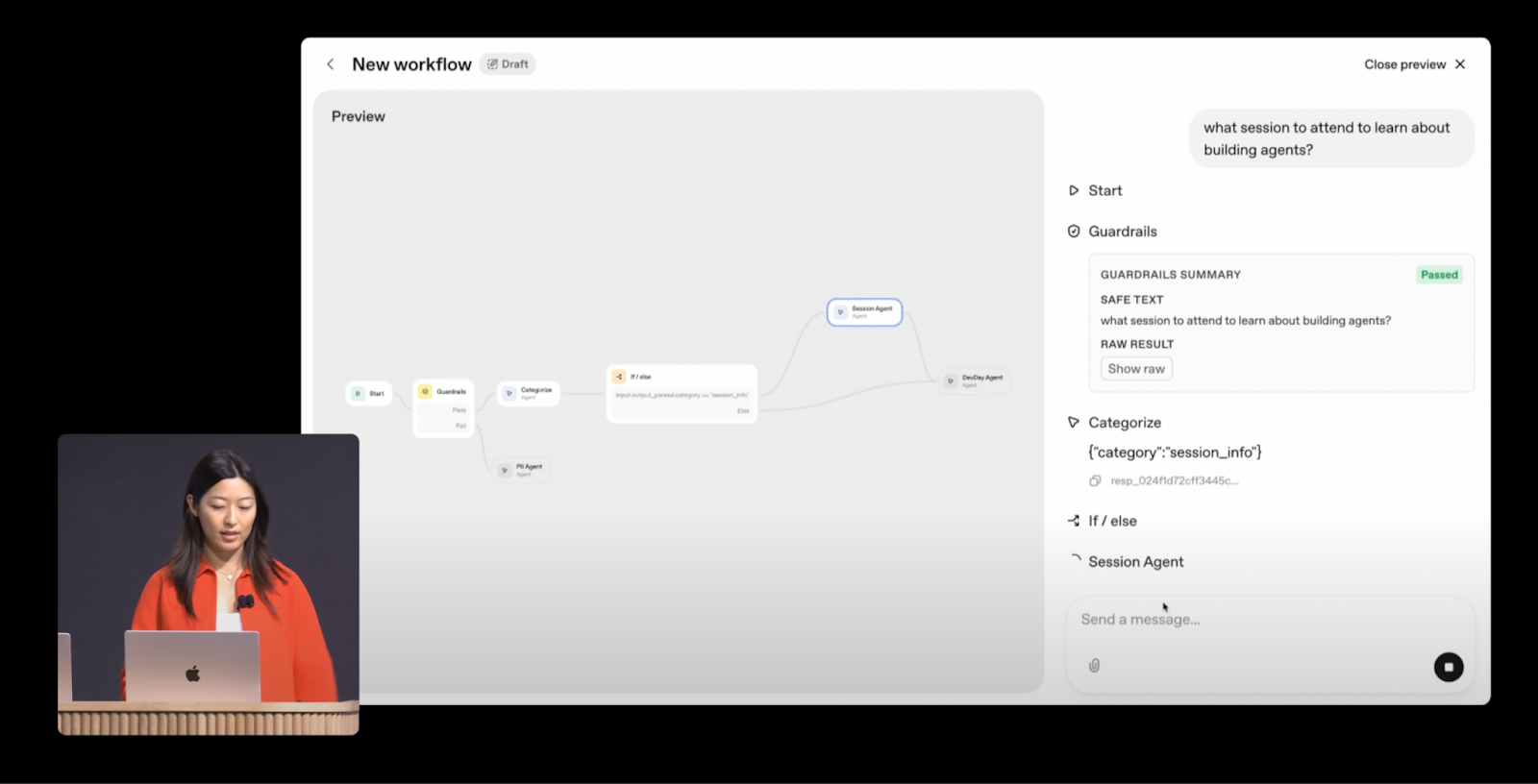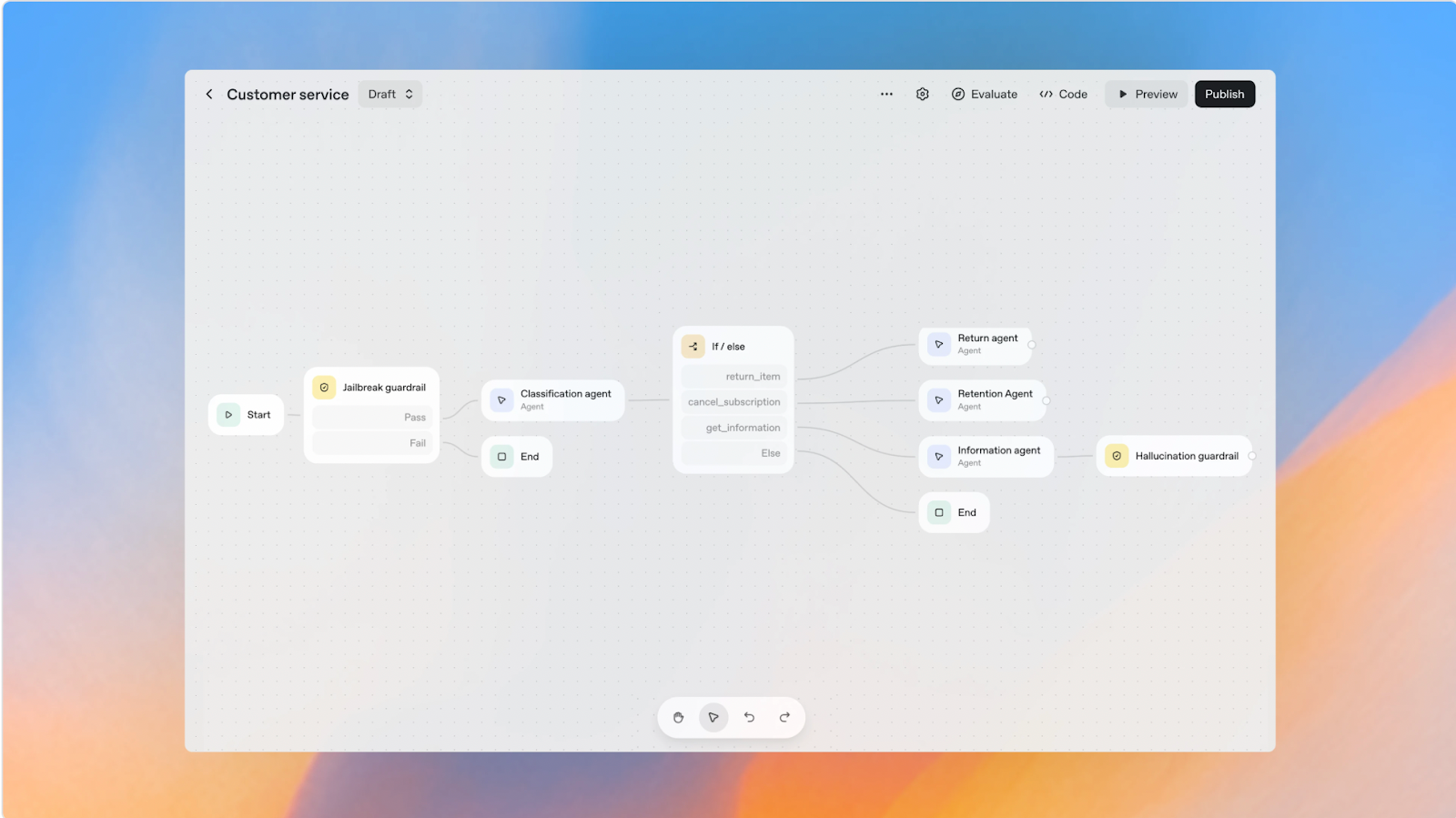OpenAI AgentBuilder: A Complete Guide to AI Agent Creation

Sam Altman calls AgentBuilder "like Canva for building agents", a bold comparison that's backed by impressive results. During a live demonstration at DevDay 2025, data scientist Christina Huang built a complete agent workflow in under 8 minutes, showcasing just how dramatically this platform has transformed AI development.

AgentBuilder is OpenAI's groundbreaking no-code visual platform that democratizes AI agent creation, allowing anyone from developers to business analysts to build sophisticated AI workflows without writing complex code. The platform matters because early adopters like Ramp and Klarna are already seeing 50-70% time savings while handling customer workflows at unprecedented scale, with Klarna's agent now managing two-thirds of all customer tickets.
Understanding AgentBuilder's Core Capabilities
At its heart, AgentBuilder replaces months of complex orchestration code with an intuitive visual drag-and-drop canvas. Users connect functional nodes, think of them as building blocks, to create multi-step AI workflows that would traditionally require extensive programming expertise.
The platform provides pre-built nodes for common functions: agent nodes for AI reasoning, logic gates for decision-making, API calls for external integrations, and input/output nodes for data flow. These components snap together like digital Lego blocks, making it possible to map out sophisticated processes in minutes rather than months.
Built-in tools expand the platform's capabilities significantly. AgentBuilder includes native support for web search, file search, and image generation, allowing agents to access real-time information and create visual content. The platform also integrates seamlessly with OpenAI's Responses API and new Agents SDK, providing a solid technical foundation while maintaining the visual simplicity.
Customer Support Automation
The most transformative use case has been in customer service. Klarna's implementation stands as the gold standard, their AgentBuilder-powered agent now handles two-thirds of all customer tickets, fundamentally changing how the company approaches support.
The typical workflow follows a logical pattern: incoming tickets are automatically classified by intent, the agent searches relevant knowledge bases for solutions, and then either provides a complete response or intelligently routes complex issues to human specialists. This is an intelligent triage that understands context and nuance.
Internal Business Workflows
Ramp's expense management agent showcases the platform's internal automation potential. Built in under 2 hours, their system handles approval routing, policy checking, and automated notifications, tasks that previously required custom development spanning months.
The beauty lies in the simplicity: employees submit expense requests through a familiar interface, the agent checks against company policies, routes approvals through the proper channels, and sends notifications at each step. What once required multiple manual touchpoints now flows seamlessly through an automated pipeline.
Sales and Growth Agents
Clay's remarkable 10× growth through automated outreach demonstrates AgentBuilder's revenue-driving potential. Their agent handles the entire sales funnel: qualifying leads based on complex criteria, crafting personalized emails that feel human-written, and scheduling meetings when prospects show interest.
These aren't simple mail-merge operations. The agents understand context, research prospects, and adapt their approach based on responses, essentially replicating the work of an entire sales development team.
Research and Analytics Pipelines
For data-intensive operations, AgentBuilder enables multi-agent coordination that mirrors how human research teams collaborate. One agent might gather data from web searches, another queries internal databases, while a third synthesizes findings into actionable reports.
Financial firms are using these workflows to automate market research that previously required teams of analysts. The agents can pull regulatory filings, analyze news sentiment, run financial models, and produce comprehensive reports, all while maintaining accuracy through built-in validation steps.
Visual Canvas System

The canvas is where AgentBuilder's power becomes tangible. Node types serve specific functions: Agent nodes handle AI reasoning, Logic nodes create conditional branches and loops, Tool nodes connect to external services, and Guardrail nodes ensure safety and compliance.
Templates for common use cases accelerate development further. Instead of starting from scratch, users can modify pre-built workflows for customer service, document processing, or data analysis. The platform includes comprehensive version control, enabling teams to branch workflows, save iterations, and roll back changes, crucial features for enterprise collaboration.
Enterprise Connectors
The Connector Registry transforms AgentBuilder from a standalone tool into an enterprise integration platform. Out-of-the-box connectors for Dropbox, Google Drive, SharePoint, and Microsoft Teams mean agents can access company data without custom coding.
Agents can securely query databases, pull specific documents based on context, and respect existing permissions. The platform also supports MCP-compatible data sources, ensuring compatibility with modern enterprise architectures.
Early adopter results speak volumes: 50% reduction in development time and 30% accuracy improvement they're becoming the norm. Carlyle's multi-agent due diligence workflow exemplifies these gains, transforming a months-long development project into a two-day sprint.
However, this tight integration comes with a critical tradeoff: vendor lock-in. AgentBuilder's connectors and infrastructure are designed exclusively for OpenAI's ecosystem, meaning organizations are betting their entire AI strategy on a single provider. As AI models evolve rapidly and different providers excel at different tasks, this limitation can become costly. Enterprises are increasingly seeking solutions that allow them to leverage best-of-breed models, whether that's Claude for complex analysis, GPT for conversational tasks, or Gemini for multimodal workflows,without rebuilding their entire infrastructure. This flexibility is becoming a strategic imperative as the AI landscape continues to evolve at breakneck speed.
Observability and Monitoring
For teams deploying agents at scale, monitoring and optimization become critical. While AgentBuilder offers basic native monitoring, teams seeking enterprise-grade observability are turning to dedicated platforms like PromptLayer as a superior solution.
PromptLayer provides comprehensive logging, prompt versioning, and performance analytics that go beyond what's available in AgentBuilder's built-in tools, enabling teams to:
- Track every agent interaction and decision point across all deployments
- A/B test different prompt strategies and measure real performance impact
- Monitor costs and performance across deployed agents
- Debug issues by replaying exact agent conversations
- Mix and match models from OpenAI, Anthropic, Gemini, and other providers without being locked into a single ecosystem
This model-agnostic approach is crucial for enterprises that want flexibility in their AI strategy. Rather than being constrained to OpenAI's ecosystem, teams can optimize each workflow with the best model for the job, using Claude for complex reasoning, GPT-4 for general tasks, and Gemini for multimodal workflows, all while maintaining unified observability and governance.
This observability layer is essential for enterprise deployments where agents handle thousands of interactions daily and where vendor flexibility can mean the difference between scaling successfully or hitting platform limitations.
Acting on the AI Shift
The early business results are undeniable: dramatic efficiency gains across customer support, sales operations, and internal workflows. Companies aren't just saving time, they're discovering entirely new ways to leverage AI that weren't feasible with traditional development approaches.
Looking forward, the platform's roadmap promises even greater capabilities. The upcoming Workflows API will enable programmatic management of complex flows, ChatGPT integration will bring agents directly to millions of users, and GPT-5 support will unlock new levels of reasoning and capability.
The message is clear: as AgentBuilder matures beyond beta, it's positioned to become the mainstream platform for AI-driven application development. Organizations that start experimenting now, even with simple prototypes, will be best positioned to capitalize on this transformation. The question is how quickly you can begin transforming your workflows with this game-changing platform.



